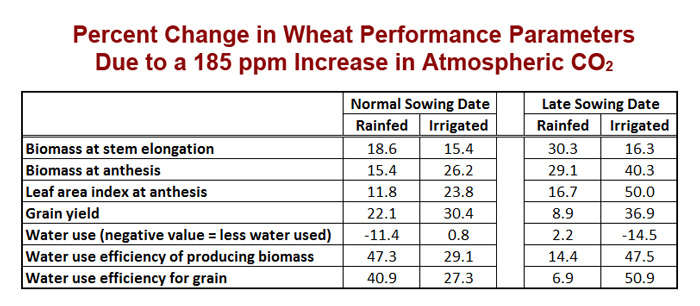| Tweet | Follow @co2science |
Paper Reviewed
O'Leary, G.J., Christy, B., Nuttall, J., Huth, N., Cammarano, D., Stõckle, C., Basso, B., Shcherbak, I., Fitzgerald, G., Luo, Q., Farre-Codina, I., Palta, J. and Asseng, S. 2015. Response of wheat growth, grain yield and water use to elevated CO2 under a Free-Air CO2 Enrichment (FACE) experiment and modelling in a semi-arid environment. Global Change Biology 21: 2670-2686.
Introducing their work, O'Leary et al. (2015) write that "models that include some realistic simulation of the effects of elevated atmospheric CO2 (eCO2), temperature and water stress on crop growth and development are considered a prerequisite in terms of model function for future climate change studies." They also note that "comparison against measured field data is fundamental to improving crop models," citing Boote et al. (1996). Consequently, in light of these facts, O'Leary et al. set out to test "the performance of six wheat crop models against 3 years of measured crop growth and water use data" from the Australian Grains Free-Air CO2 Enrichment (AGFACE) facility located in Horsham, Australia, a semi-arid site in southern Australia. Although much of their paper was focused on the performance of the models, this review focuses on the actual data obtained over the course of the experiment.
The analysis was restricted to one wheat cultivar, Yitpi, which was grown under "two water regimes (rain-fed and supplemental irrigation), two nitrogen fertilization regimes (0 and 53-138 kg N ha-1) and two sowing dates (to create two growing season temperature environments) for both daytime ambient (365 µmol mol-1) and elevated (550 µmol mol-1) CO2 atmospheric conditions." Compared with ambient CO2 conditions, elevated CO2 alone increased wheat biomass at stem elongation and anthesis by 20.5 and 25.8 percent, respectively. Leaf area index and leaf plus stem area index at anthesis were also enhanced by 23.1 and 30 percent, respectively, leading to an overall grain yield increase of 25.5 percent in response to the extra 135 ppm increase in CO2. Water use efficiency was also improved by elevated CO2 (33 percent); and wheat plants growing in CO2-enriched air used on average six percent less water than wheat plants growing in ambient air.
In discussing the interactive effects of elevated CO2, nitrogen fertilization, watering regime and sowing date, the authors report there were "no effects of applied N on growth due to the high levels of soil mineral nitrogen content at the site." With respect to water regime and sowing date, Table 1 below indicates the effects of elevated CO2 were overwhelmingly positive, improving the performance of various growth parameters and plant water use efficiency. As a result of these findings, it can be concluded that rising atmospheric CO2 concentrations over the next few decades will benefit wheat growth, water use efficiency and yield, helping to improve the production of this important food crop that will be needed to feed the ever-increasing population of the planet.

Table 1. Percent change in various wheat performance parameters due to a 185 ppm increase in atmospheric CO2. Source: O'Leary et al. (2015).
Reference
Boote, K., Jones, J. and Pickering, N. 1996. Potential uses and limitations of crop models. Agronomy Journal 88: 704-716.




